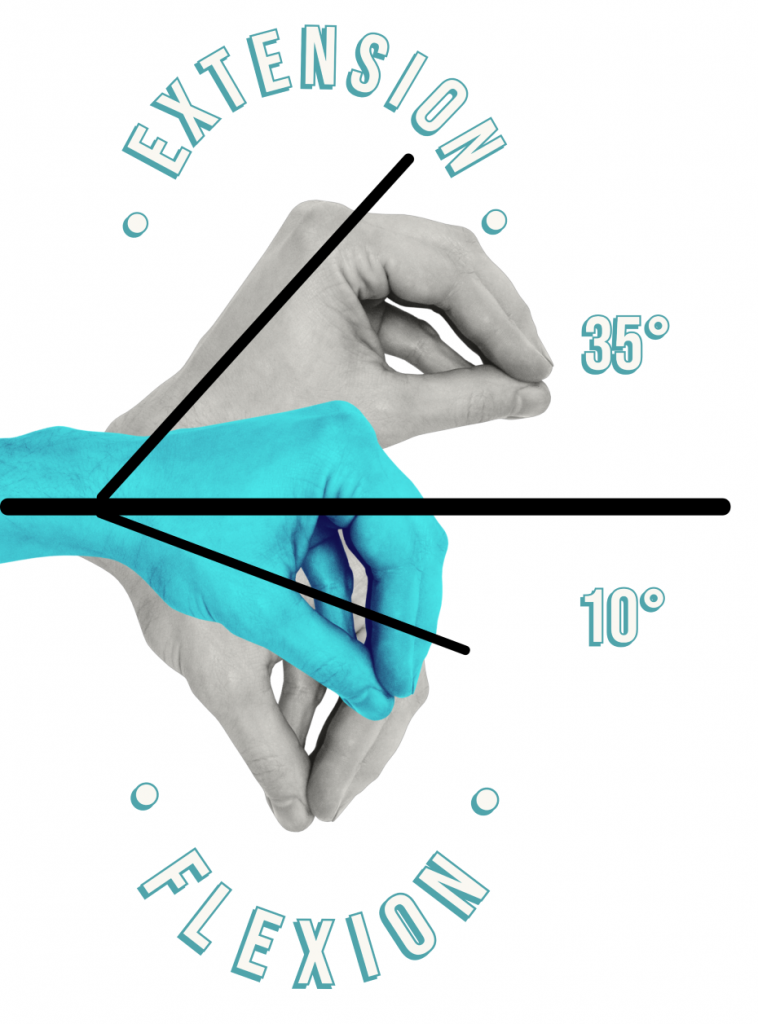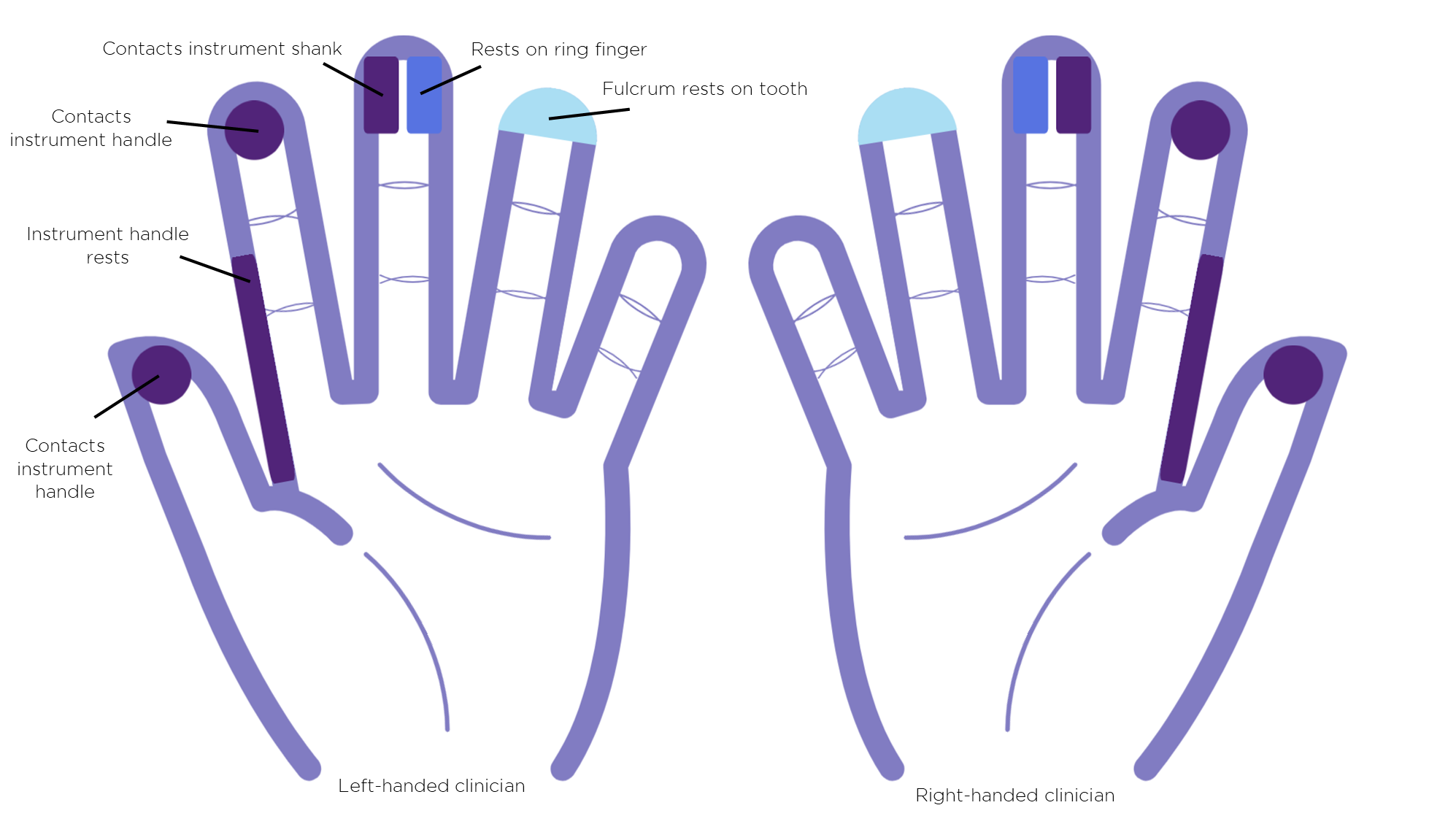Ergonomics
Instrumentation
Nicole Stormon and Sowmya Shetty
Learning Objectives
Principles
To ensure optimal safety during clinical procedures, operators employ a modified pen grasp of the instruments. This creates stable and controlled movements as well as minimising risk of fatigue.
Instrument grasp
The optimal grasp of dental instruments have been employed for the safety of the operator and patient during technical procedures. Dental instruments often have sharp working-ends, therefore stable and confident use of instruments are essential. Safe instrumentation of dental instruments begins with optimal posture (explained in previous chapters) and correct arm and wrist positioning. Upper arms and elbows should be against the side of the body. Forearms parallel to the floor and wrists in a natural position.
 Flexion is the bending movement of a joint that decreases the angle between the bone and the limb. Extension is the bending movement that increases the angle. Natural positioning of the wrist minimises the pressure in the carpal tunnel during movement. Extension outside of neutral positions increases the risk of injury in the wrist and hand. Any movements required outside of optimal wrist flexion and extension ranges should be achieved by moving the entire hand, wrist and forearm. Normal flexion should not exceed 10° and extension 35°.
Flexion is the bending movement of a joint that decreases the angle between the bone and the limb. Extension is the bending movement that increases the angle. Natural positioning of the wrist minimises the pressure in the carpal tunnel during movement. Extension outside of neutral positions increases the risk of injury in the wrist and hand. Any movements required outside of optimal wrist flexion and extension ranges should be achieved by moving the entire hand, wrist and forearm. Normal flexion should not exceed 10° and extension 35°.
A three-point pinch grip is utilised when grasping dental instruments. Hand strength is stronger when assuming a pinch grip position and can alleviate and minimise the force required from wrists and arms. A three-pinch grip is when the thumb is placed on one side of the instrument and index and middle finger on the other side. To minimise injury, the operator should apply minimal pressure when gripping the instrument. During instrumentation the grip on the instrument can be increased.
A pen grasp is a type of pinch grip used for writing implements. The thumb, index and middle fingers are placed in a tripod position to grasp the pen/pencil. In dentistry a modified pen grasp is used. The middle finger is modified and the side of the finger placed on the shank of the instrument. The index finger is bent at the second joint and is positioned above the middlemodified pen grasp finger on the same side of the handle. The pad of the thumb is placed midway between the middle and index fingers on the opposite side of the handle.

Fulcrum
A fulcrum is a support at a point in which a lever turns. A fulcrum is always used during dental instrumentation. The fulcrum anchors the hand and instrument to the area which it is being used. This minimises unintentional movement of the instrument when undertaking precises procedures. The fulcrum should ideally be as fulcrumclose to the working area as possible, however this is not always possible. Intra-oral fulcrums are within the mouth and extra-oral outside of the mouth, usually on the face.
|
Fulcrum |
Description |
|
Intra-oral reinforced |
The fulcrum is placed on an adjacent tooth to the working area. |
|
Intra-oral cross arch |
The fulcrum is placed on a tooth in the quadrant opposite to the working area. |
|
Intra-oral opposite arch |
The fulcrum is placed on a tooth in the opposite arch to the working area. |
|
Intra-oral finger-on-finger |
The fulcrum is placed on another finger of the non-dominant hand. |
|
Extra-oral palm up |
Back of the palm is placed against the face for stability. |
|
Extra-oral chin cup |
The dominant hand cups the chin, generally for instrumentation in the maxilla. |
Dominant and non-dominant hand
Dental procedures often require the utilisation of instruments in both the dominant and non-dominant hand. The dominant hand will hold and use the instruments for treatment and procedures. The non-dominant hand will typically hold a mouth mirror for indirect visualisation of the maxillary arch and retract soft tissue. Both the dominant and non-dominant hand use a modified pen grasp and fulcrum for instrumentation.
Practical application to the dental environment
Clinicians may use their left or right hand as their dominant hand for procedures. Regardless of the dominant hand, the principles of instrumentation will be applied. The major difference between a right and left-handed clinician will be in their positioning around the patient. The positioning around the patient is mirrored depending on the dominant hand and this is explained further in other chapters.
Instrumentation and fulcrums are dynamic and adapt to the procedure and area where working. Movements are always made with purpose and fulcrums adapted prior to the use of the instrument. Below is an example of periodontal probing. Watch the demonstration of this procedure to see the fulcrum change position as the clinician measures the different areas of the gingiva.
Key Takeaways
- Instrument grasp in dental settings is adopted to enable optimal safety for the patient and operator, as the instruments often have a sharp working end.
- Correct grasp aids in posture, minimising risk of injury.
- Flexion is the bending movement of a joint that decreases the angle between the bone and the limb. Extension is the bending movement that increases the angle.
- A fulcrum is always used during dental examination. This is important to anchor the hand and minimise unintentional movement during precise procedures. There are two types of fulcrums, intraoral (inside the mouth) and extraoral (outside the mouth).
- Both dominant and non-dominant hands are used during dental examination. The dominant hand typically holds the instrument used for treatment and procedure, whereas, the non-dominant will hold a mirror for indirect vision of the maxillary arch and often aid in retraction of soft tissue.
The bending movement of a joint that decreases the angle between the bone and the limb.
The bending movement that increases the angle.
The thumb, index and middle fingers are placed in a tripod position to grasp the pen/pencil.
The pinch grip used to hold instruments in dental practice.
A support at a point in which a lever turns.

